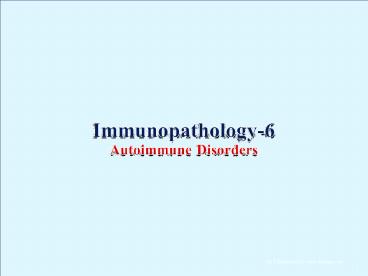Immunopathology6 Autoimmune Disorders - PowerPoint PPT Presentation
1 / 17
Title: Immunopathology6 Autoimmune Disorders
1
Immunopathology-6Autoimmune Disorders
2
Autoimmune Disorders
- Objectives
- General
- Immunologic Tolerance
- Central
- Peripheral
- Mechanisms
- Specific disorders
- SLE ( Systemic Lupus Erythematosus)
- Sjogrens Disease
- Systemic Sclerosis
- Inflammatory Myopathies
- Vascular disorders
3
Autoimmune Disorders- General
- Immune reactions against self antigens
- Incidence 1-2 of SA population(increasing)
- Criteria for inclusion into autoimmune disorders
- Autoimmune reaction
- Not secondary to tissue damage
- No other simultaneous known cause
- Can be due to CMI or AMI
- Types
- Organ specific Hashimoto, MS, Type I DM
- Limited organ involvement Goodpasture's
- Generalized or Systemic SLE
- Physiological Auto- Ab are seen in
- Elderly
- Following tissue damage
4
Autoimmune Disorders- Immunologic Tolerance
- Definition incapable of developing immune
response against self Ag - Types
- Central
- Peripheral anergy (functional inactivation),
Regulatory T cell mediated suppression, CD4
mediated (Fas- Fas ligand) clonal deletion, Ag
sequestration
5
Autoimmune Disorders- Mechanisms
- Role of Susceptibility Genes HLA Non HLA
genes are involved - Role of Infections
- up-regulate the expression of co- stimulators on
APC or - Molecular mimicry (microbes may express
antigens with same amino acid sequences as
self-antigens) - progression and chronicity mainly by epitope
spreading
6
Autoimmune Disorders - SLE
- Chronic, relapsing remitting disease
- Organs involved skin, joints, kidney and serosal
membranes - Age, Ethnicity Gender women of childbearing
age African American - Criteria for diagnosis 4 of 11 if present
serially or simultaneously(next slide) - Etiology and Pathogenesis
- Cause is unknown
- Multisystem disease of autoimmune origin
- Multifactorial disorder
- fundamental defect failure of the regulatory
mechanisms that sustain self-tolerance - of antibodies against Nuclear and cytoplasmic
components - IMMUNNE FACTORS
- visceral lesions (Type III HR) Hematological
disorders (Type II HR) - MORPHOLOGY
- Arterioles
- Acute necrotizing Vasculitis
- Chronic fibrous thickening and luminal
narrowing
7
SLE Diagnostic Criteria
8
SLE
9
SLE Morphology
- MORPHOLOGY
- KIDNEY (lupus nephritis)
- 5 patterns (WHO classification)
- Class I (rare) normal by LM, IFM and EM
- Class II mesangial lupus glomerulonephritis
(GN) - Class III focal proliferative GN (hematuria and
proteinuria) - Class IV diffuse proliferative GN Most serious
Cresentic GN (very bad prognosis) present with
nephrotic syndrome HTN and renal insufficiency - Class V membranous GN MC C of nephrotic
syndromes in adults - Mesangial immune complexes deposits earliest
change (always present ) - IFM (Immunofluorescence Microscopy) granular
deposits of Ig complement (unlike linear in
Goodpasture Syndrome) - Wire-loop lesions subendothelial deposits (poor
prognosis) - SKIN erythema butterfly rash (onlyin 50
pts.) Liquefactive degeneration of the basal
layer of the epidermis Vasculitis with fibrinoid
necrosis IG complement deposits at
dermoepidermal junction (Band test)
10
SLE- FPGN
11
SLE- DPGN
12
SLE- Wire loops
13
SLE- Band test
14
SLE- Spleen
15
SLE
- MORPHOLOGY
- JOINTS nonerosive synovitis
- CNS acute Vasculitis Or endothelial injury
?intimal proliferation - CVS
- Pericarditis common
- Myocarditis resting tachycardia EKG
abnormalities - Endocarditis Libman Sacks -Stenosis or
regurgitation valve thickening affects mitral
and aortic valves vegetations (thrombi) on both
sides of valves - Coronary Artery Disease Young patients with
longstanding SLE who are treated with steroids - SPLEEN splenomegaly with Follicular hyperplasia
perivascular fibrosis (onion-skin lesions) - LUNGS Pleuritis and Pleural Effusions (common)
- OTHER ORGANS
- Liver (portal triaditis ) Bone Marrow
(hematoxylin bodies) Lymph nodes(enlarged with
hyperactive (B-cell activation)follicles
16
SLE
- CLINICAL COURSE multisystem disease with Highly
variable clinical presentation clinical course - Typical patient Young woman with Butterfly rash
over face Fever Joint pain but no deformity
Pleuritic chest pain Photosensitivity. - ANAs can be found in virtually 100 of patients.
- Clinical features Renal (hematuria, red cell
casts, proteinuria and nephrotic syndrome)
Hematologic (Anemia, thrombocytopenia) CNS
(psychosis or convulsions) Infections - Most common causes of death Renal failure
Intercurrent infections CNS disease and CAD - Variants
- Chronic Discoid Lupus Erythematosus
- Prominent Skin involvement (mainly face and scalp
discoid lesions only 35 have ANA positive
only involved skin shows Band test positivity - Sub acute Cutaneous Lupus Erythematosus
predominant skin involvement (Widespread but
superficial nonscarring lesions) Antibodies to
SS-A antigen HLA-DR3 genotype
17
Drug induced SLE
- Drug-induced Lupus Erythematosus
- Hydralazine
- Procainamide
- Isoniazid
- D- penicillamine
- No symptoms
- Multiple organs involved but renal and CNS
involvement very uncommon. - Antihistone antibodies very important
- HLA-DR4 at a higher risk after hydralazine
therapy.































